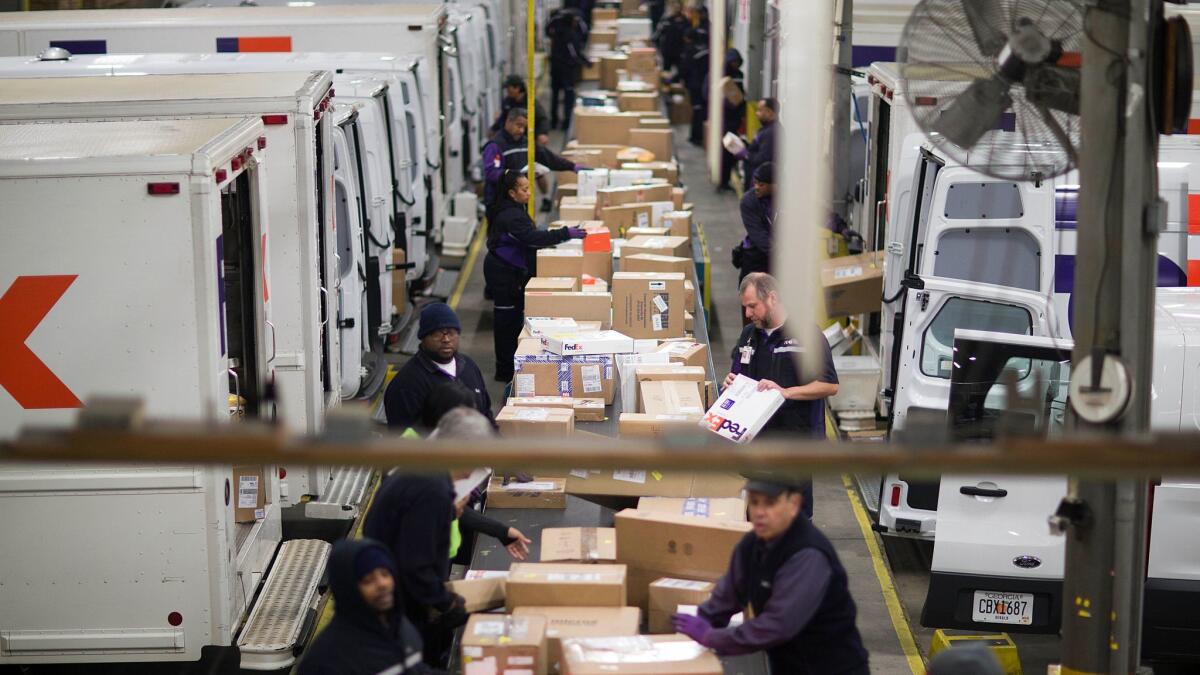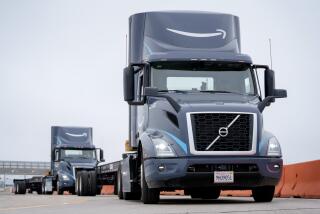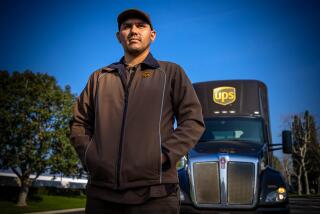The shipping industry is poised for massive upheaval. Can FedEx weather the storm?

Between 10 and 11:30 p.m., as most of Memphis is winding down for the night, the FedEx Express World Hub is revving up for its busiest hours of the day.
Some 10,000 workers pour into the campus, ready to begin a mind-bogglingly complex ritual of steering packages to customers’ doorsteps on time. Hundreds of equipment operators zoom around the 880-acre site on warehouse tugs, pulling trains of silver shipping containers shaped like half-igloos. In an earsplitting operation dubbed “the matrix,” package sorters corral boxes into a single-file line for a trip down a tangle of conveyor belts.
On this particular night at FedEx’s largest global facility, workers will sort some 1.3 million express packages. That number only swelled when holiday shopping kicked into high gear.
This logistical symphony has been decades in the making, the product of billions of dollars in investment in automated sortation systems and Boeing 767 cargo jets. On this night alone, air traffic controllers in the Tennessee city will usher in about 150 flights, an average of one every 40 seconds.
Analysts say infrastructure such as this makes FedEx and its rival, UPS, extremely difficult to dislodge from their thrones atop the U.S. shipping industry. Yet as dominant as they are, the stalwarts are also vulnerable, facing a fresh wave of potential disruption.
In the last year, Amazon.com has put 4,000 of its own truck trailers on the road and has leased 40 planes from an airfreight company, raising the specter of the e-commerce giant possibly becoming a competitor of the major shippers instead of one of their biggest customers.
Uber, meanwhile, has built a fast-growing business out of ferrying people around cities, leading some analysts to wonder whether its network might also be effective at moving goods. Silicon Valley upstarts such as Deliv and Postmates also are making a play for local deliveries.
And then, looking to the not-so-distant future, a host of companies pitch drones and driverless vehicles as options that could reshuffle the economics of the delivery business. Amazon announced this month that it had made its first customer delivery via drone.
Together, these developments amount to a gathering storm for FedEx’s shipping empire.
“The last time the logistics industry has had a change this big was the introduction of the ocean shipping container in the 1960s,” said Ryan Petersen, chief executive of Flexport, a freight forwarding company.
It’s a transformation that will test whether sprawling, sophisticated facilities such as the World Hub are a bulwark that protects the company or an expensive anchor that makes it hard to reposition for the future.
The central challenge
To understand the business environment that FedEx is dealing with, consider the world’s changing shopping habits. With every purchase that shoppers make online instead of at a store, they are contributing to a fire-hose gush of new demand for FedEx’s services.
But the e-commerce beast has a soft underbelly. Delivering those kinds of orders is hard to do profitably. Think about it: The labor and fuel costs required to drop off 50 sweaters at 50 homes is significantly higher than it would be to deliver those same 50 sweaters to a single store.
As supply chain geeks like to put it: Density equals profitability.
For years now, FedEx and UPS have been working to address this situation by squeezing costs out of their systems. They have introduced software to build more-efficient delivery routes, invested in automation and bought more fuel-efficient vehicles.
In some ways, FedEx and UPS are almost impossibly good at what they do: In non-peak season, each of their on-time rates is 98% or greater, according to Shipmatrix, a logistics software firm. (During this holiday season and previous ones, that performance has slipped slightly.)
Yet none of this erases their central challenge in the e-commerce era. It is hard to deliver small packages to individual households cheaply and quickly. And newcomers are plotting ways to attack that problem. Their efforts aimed at various points in the logistics chain could collectively eat into the big shippers’ business.
Change is sweeping in
FedEx’s scale is, by any measure, enormous. It has 650 aircraft, a fleet bigger than most commercial airlines’. It has more than 150,000 vehicles, employs about 400,000 people and moves about 12 million packages a day. (UPS moves about 18.3 million a day.)
The express business relies heavily on the planes to provide overnight shipping around the world. Parcels that aren’t quite so urgent might be moved via trucks in the less pricey FedEx Ground service.
For e-commerce packages, the company has options for the “last mile” of delivery. Via Smartpost, they can hand off packages to the U.S. Postal Service, which will drop off them off during regular delivery hours. Or uniformed FedEx drivers — often independent contractors, not employees — can bring them to your home.
But change is sweeping in from all directions. In addition to potential moves by Amazon and Uber, regional and local delivery networks are springing up or expanding. And then there’s the new, futuristic technology.
“Drone delivery will be the future of what we experience as consumers,” said Russell Walker, a clinical professor at Northwestern University’s Kellogg School of Management, who has studied the concept.
Sure, FedEx is perfectly capable of ramping up on drone technology as that becomes a reality. But doing so introduces a host of uncertainties. Drones theoretically could cut costs by reducing trips for human drivers. Yet they can’t carry many items, and they can’t carry especially big items. Remember the industry’s “density equals profitability” mantra? Drones don’t necessarily fit that bill.
And autonomous vehicles raise difficult questions about big shippers’ massive workforces. Some workers may have to be retrained for more tech-centric jobs such as repairing those driverless trucks, and some workers may no longer be needed. Again, Amazon or some other newcomer would not have to deal with these emotional legacy issues. (Jeffrey P. Bezos, chief executive of Amazon, owns the Washington Post.)
Still, FedEx has already proved, to some extent, that it can adjust to dramatic change. For some perspective: Back in 2008, FedEx thought that it hit a major milestone when, on a single day during the holiday rush, it delivered 10 million packages. Patrick Fitzgerald, FedEx’s senior vice president of marketing and communications, remembers that it felt like a herculean effort — a big win. Now, FedEx moves more packages than that every day. Last Christmas season, on three separate Mondays, it moved 25 million packages.
But this cycle of change could end up being of a different magnitude. Consider this: In September, Mercedes-Benz announced a concept car it calls the Vision Van. As the vehicle zips through urban neighborhoods, automated drones could fly out of it, delivering parcels to homes. Essentially, the van becomes a cargo-storage facility on wheels.
Sure, this kind of system is not yet a reality on U.S. streets. But it is exemplary of a future that big companies are already imagining.
Potential rivals?
You can tell from the tone in FedEx officials’ voices that they are tired of being asked whether they are worried about Amazon’s latest moves. In some ways, you can’t blame them.
Amazon has stated repeatedly that its new planes and truck trailers are meant to supplement, not replace, its business with big shippers. The retailer is using those vehicles to transport goods from one Amazon facility to another, not to make deliveries to customers.
Despite that publicly proffered explanation for its logistic investments, Amazon is reportedly exploring building out something much more robust, an end-to-end shipping network that would enable it to take its delivery efforts in-house.
In theory, that’s where things could get worrisome for FedEx, because it could mean losing one of its biggest customers. But actually, if Amazon did wean itself from the shipping giants, the blow wouldn’t necessarily be devastating. FedEx says no customer accounts for more than 3% of its revenue.
Plus, there are reasons to question whether Amazon would even want to build an internal equivalent of FedEx or UPS.
For starters, the capital expenditures to get there would be massive.
“When you have more than 500 aircraft and more than 100,000 vehicles and state-of-the-art automation and sortation ... that scale took a lot of time and investment,” said Fitzgerald, the FedEx executive.
Still, Amazon — the company that got its start selling books and now makes tablets and TV shows, and provides cloud computing storage — has a way of barreling into new industries.
“Amazon is the likes of which we’ve never seen,” said Dick Metzler, a former FedEx executive who now oversees marketing at UShip, an online freight marketplace. “So there’s no way you can rule it out.”
And with Amazon Flex, a nascent network of on-demand delivery drivers, it is showing at least some interest in creating its own pipeline for getting packages to consumers.
The Flex network functions similarly to Uber, the San Francisco company that has reportedly risen to a $68-billion valuation as its ride-hailing app has transformed taxi service in America’s urban hubs.
So couldn’t Uber become a FedEx competitor, using its drivers to deliver online purchases to your front door? Potentially, experts say, but there are reasons it might not offer serious competition to the big shippers.
Uber was built for connecting riders and drivers for a single trip from Point A to Point B. It is not optimal for efficiently taking a bundle of packages from Point A to many different destinations in a single trip. Its drivers often hit the road in small sedans or compact cars — not exactly efficient for cramming in lots of boxes. However, Uber did announce in August that it had bought Otto, a start-up focusing on self-driving trucks.
There are other challenges too.
“If I’m using Uber [for a ride], they don’t need to know my height and weight. They don’t need to carry me up to the 28th floor,” Metzler said. “All those things come into play with parcel delivery.”
The industry’s efforts
Even as FedEx is skeptical of would-be challengers, it is working on ways to address the challenges that e-commerce presents. Some of that is through investment in such things as more-advanced sortation capabilities.
But the top shippers are also aiming some of these efforts squarely at the shopper. Both FedEx and UPS are eager to trumpet their expansion of “access points,” in which customers can opt to have a shipment routed to a designated convenience store, supermarket or other location. This enables online shoppers to pick up packages whenever they want, instead of having them left on a doorstep where they might be vulnerable to thieves or weather.
But make no mistake: This is also an effort to help shippers achieve greater profitability. It is better for the bottom line if drivers use just one access point in a given neighborhood instead of zigzagging to a dozen individual houses.
Analysts aren’t convinced that access points will be a game changer. After all, didn’t many people shop online in the first place because they didn’t want to make a trip to the store?
“On the margin, in certain markets, it helps, but it doesn’t really move the needle,” said Dave Ross, a transportation and logistics analyst at Stifel, Nicolaus & Co.
And when people shop online, retailers usually don’t let them select a preferred shipper. If you couldn’t choose FedEx for your shipment in the first place, what good is it if the company has an ultraconvenient access point right next to your home? FedEx says that kind of choice and control will probably become available over the next 10 years or so, but the industry is not there yet.
In other words, these kinds of small measures might not be enough. FedEx might still have to make bigger gambles to stay relevant.
Halzack writes for the Washington Post.
ALSO
California biodiesel companies hunker down — and hope
Morning TV wars heat up as NBC and CBS gain on ABC’s ‘GMA’
Uber defies DMV’s order to cease self-driving car program in San Francisco
More to Read
Inside the business of entertainment
The Wide Shot brings you news, analysis and insights on everything from streaming wars to production — and what it all means for the future.
You may occasionally receive promotional content from the Los Angeles Times.










